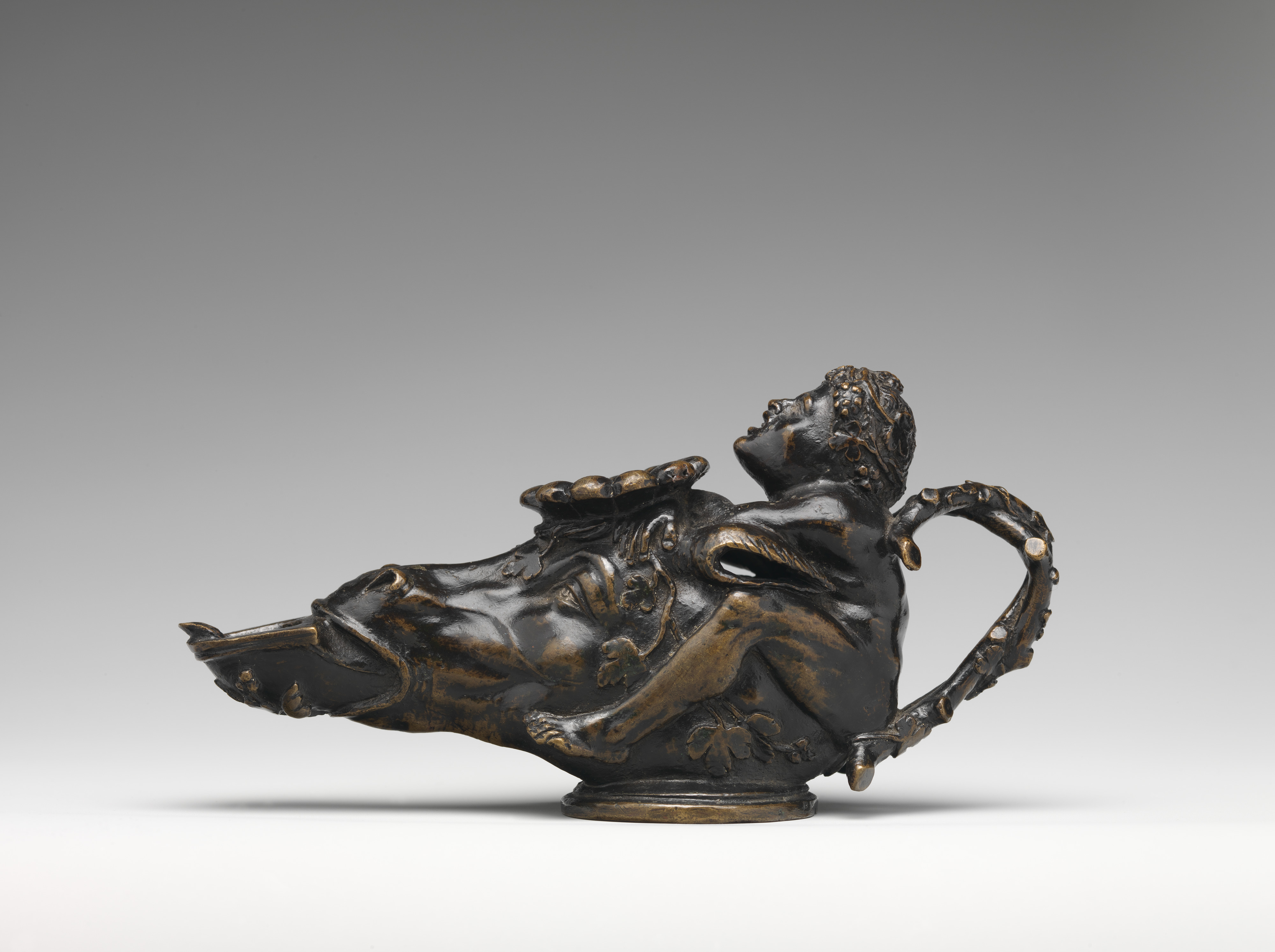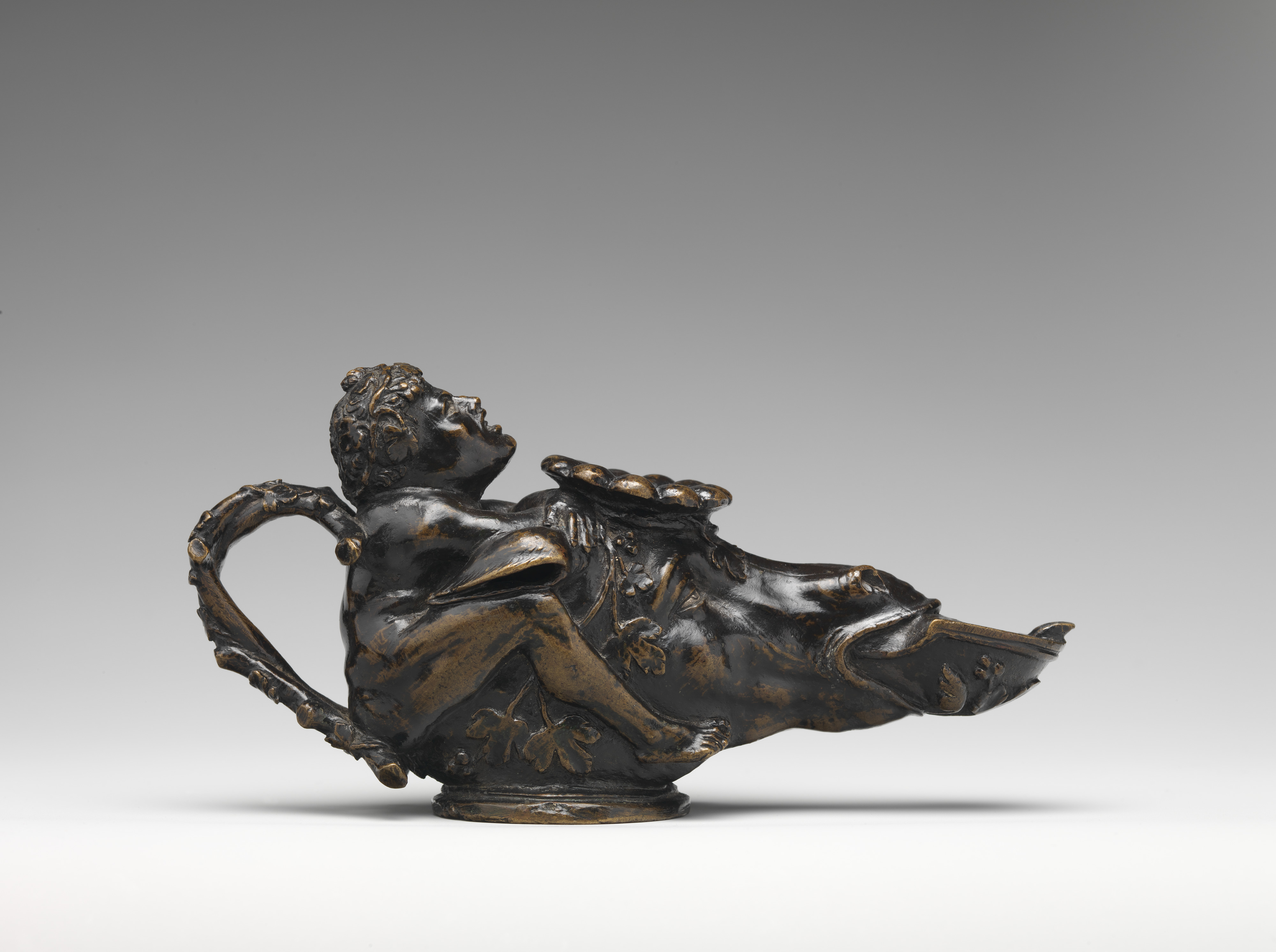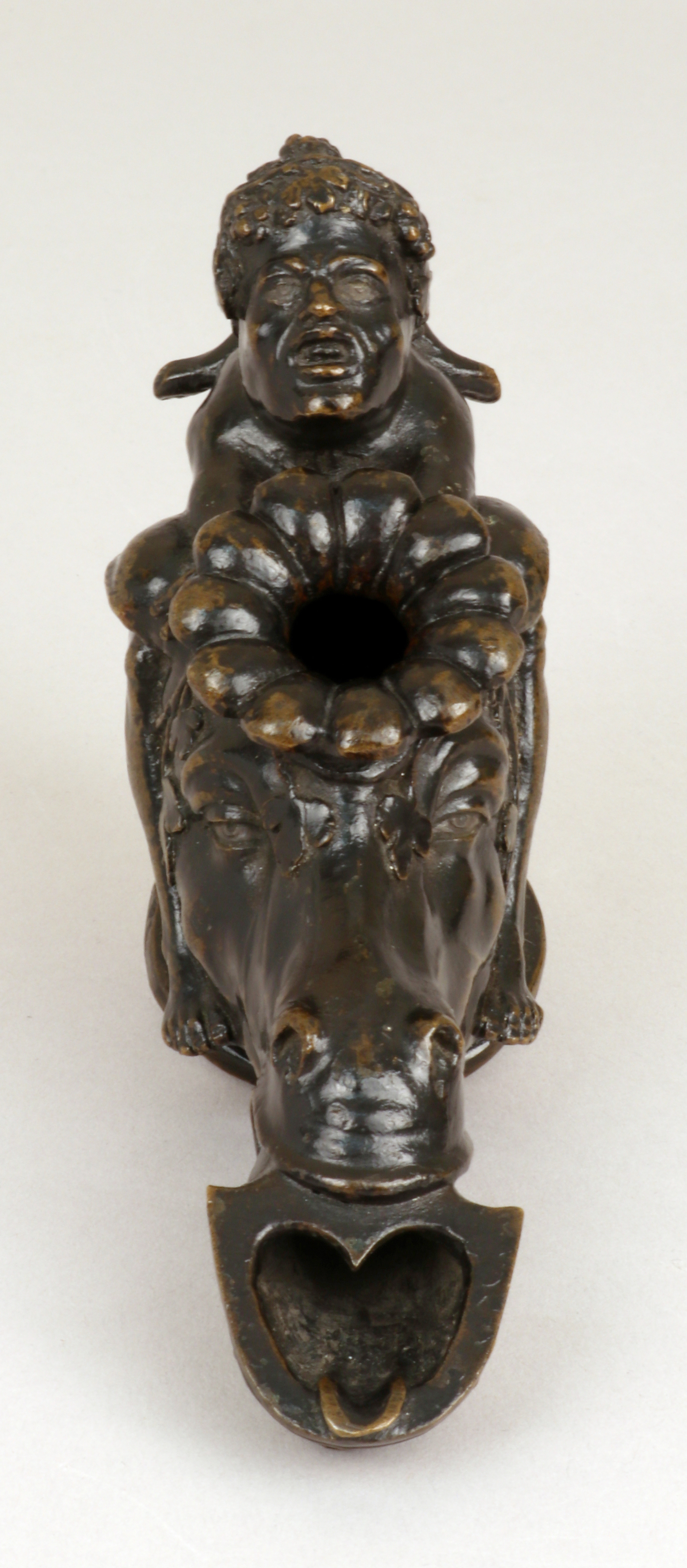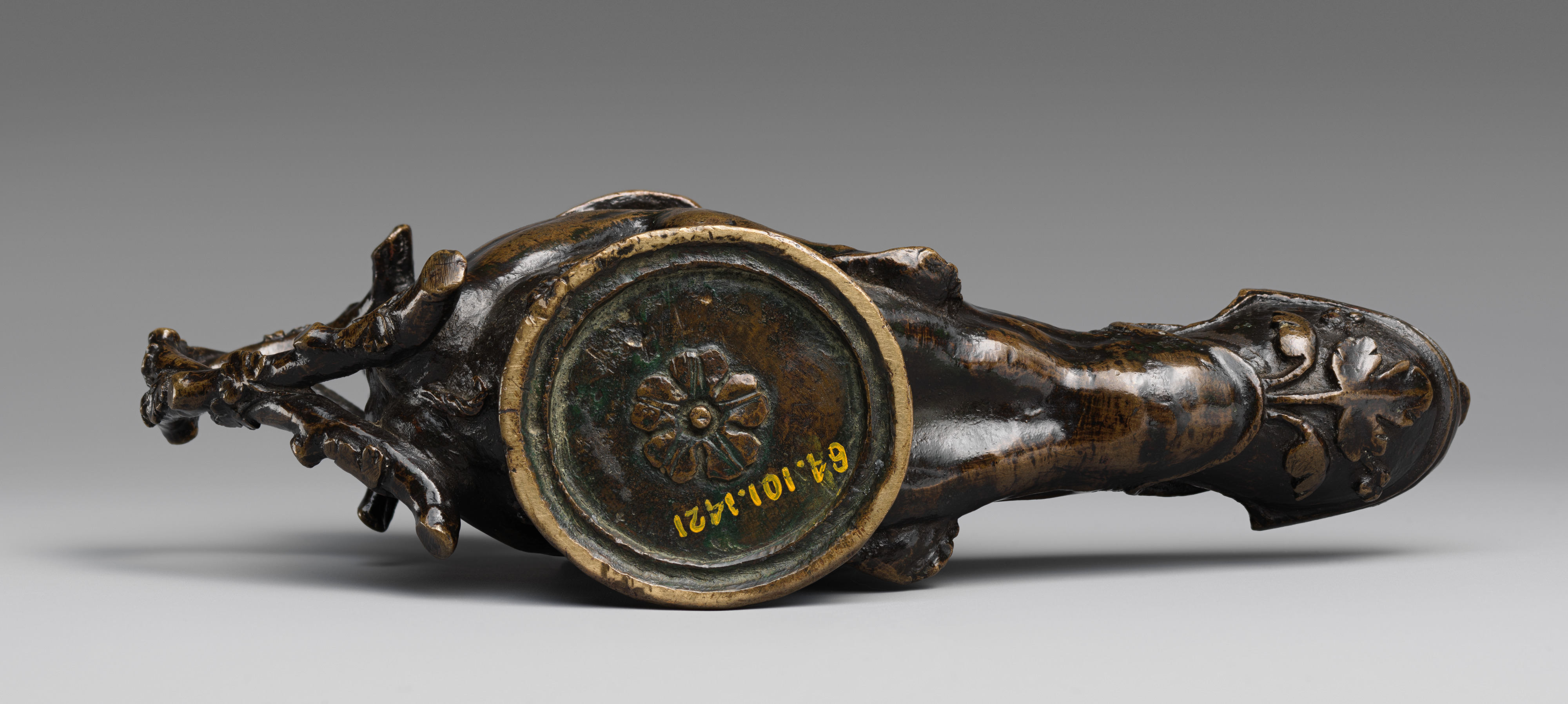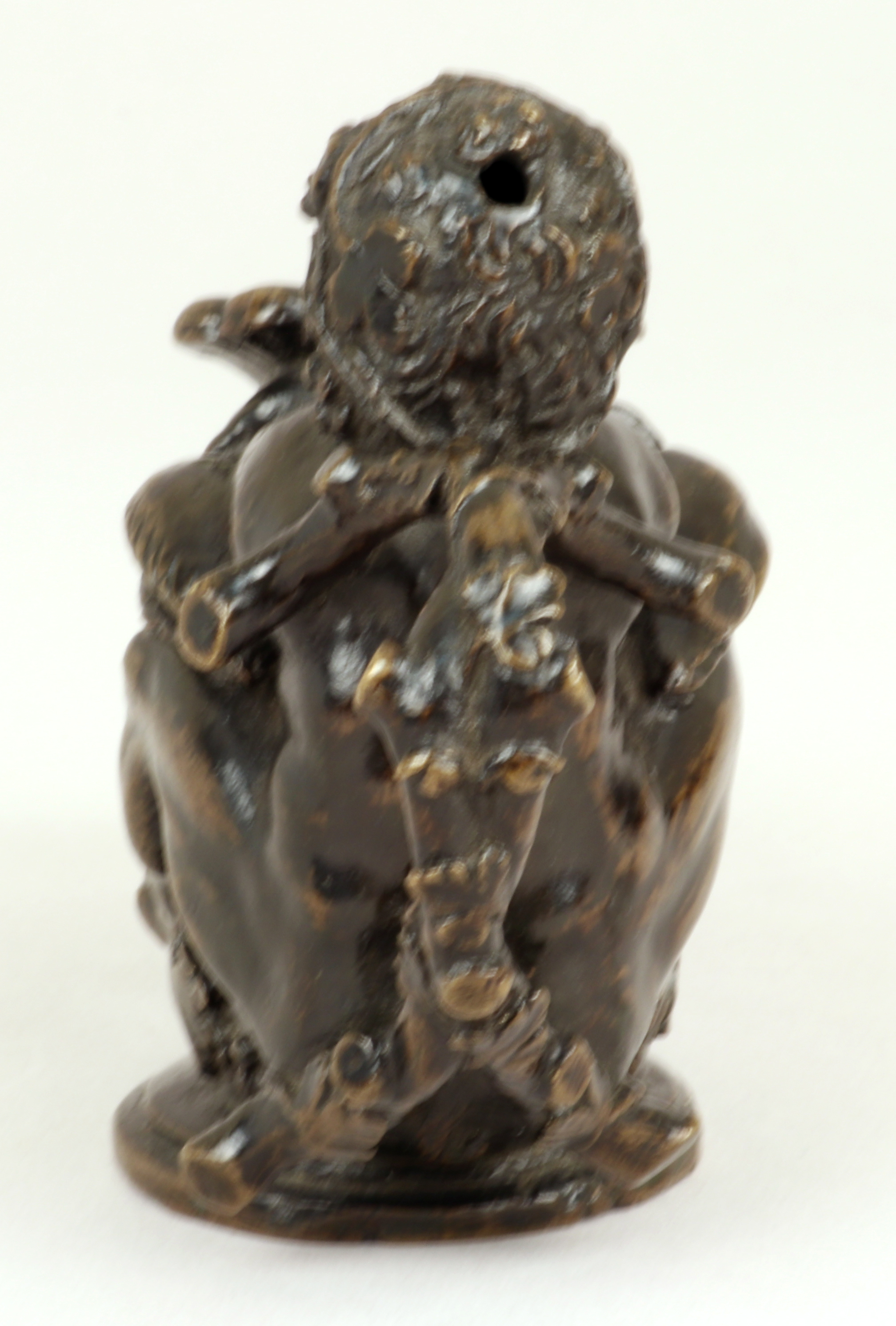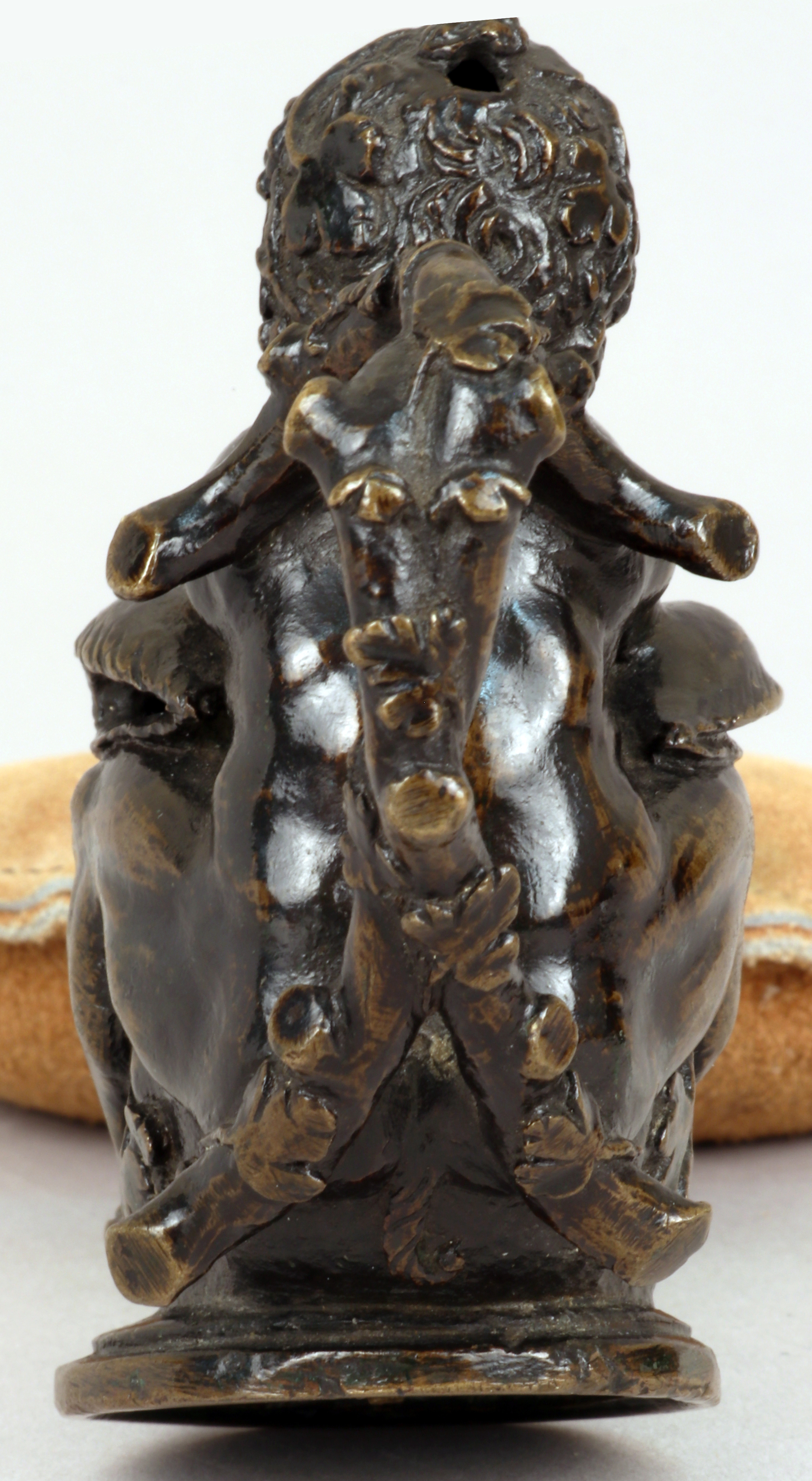Oil lamp in the form of a dwarf on a donkey’s head
Manner of Andrea Briosco, called Riccio Italian
Not on view
A small man astride the head of a donkey wears a crown of leaves in his hair. Vines and branches weave around the handle at the figure’s back. The oil lamp has an opening at the top in the form of a lotus leaf whose sprawling vines spill out onto the donkey’s head. The animal’s ears provide for air circulation. A wick pan protrudes from its mouth like a tongue to hold a wick in place.
The bronze entered The Met’s collection in 1964 as a gift from Judge Irwin Untermyer. It joined a cast of the same composition acquired by W. R. Valentiner in 1911.[1] The present cast was considered superior, and Valentiner’s bronze was deaccessioned in 1986.[2] These are two of the nearly two dozen extant versions of the model, the sheer number of which attests to its ubiquity in the Renaissance and thereafter.[3] The various lamps feature several different figure types. Leo Planiscig delineated four: a bearded man, sometimes considered Bacchus; a satyrlike grotesque; a man wearing a Phrygian cap; and a youth, as in the Untermyer cast.[4] Other variations include the form of the aperture at top, with some having hinged lids, as well as the elaboration of the vines and leaves. The elevated quality of The Met’s cast is evident in the fine modeling, the intricate rendering of the handle, and the sensitive description of the donkey’s musculature.
Because several examples are decorated on the underside—ours with a rosette pattern (fig. 23a)—Jeremy Warren has suggested that these lamps were suspended.[5] Our lamp lacks the means for hanging, however, and the fact that its form fits so snugly in the hand and that its bottom is flat and stable argues for its place on a desk or shelf in a scholar’s study.
As a group, these oil lamps have a complicated attribution history. The earliest references go back to the seventeenth century, where already many were recorded as antiquities.[6] One appears in the frontispiece to Charles Patin’s Familiae Romanae, published in 1666, in an engraving by François Chauveau that shows Father Time and Minerva unearthing ancient Roman artifacts.[7] Several such oil lamps were catalogued as antiquities well into the late nineteenth century, and one in the Musée Calvet, Avignon, retained this status into at least the 1960s.[8]
These pseudoantiques were first recognized as products of the sixteenth century by C. D. E. Fortnum in the 1876 catalogue of the South Kensington Museum (now the V&A).[9] Wilhelm von Bode attributed them to Riccio in 1907, illustrating the version in the Bargello.[10] In 1924, Planiscig considered them Paduan, circa 1500, before ultimately assigning them to Riccio’s workshop in his 1927 monograph on the artist.[11] John Pope-Hennessy, writing about the version now in the National Gallery of Art, Washington, D.C, agreed that the attribution to Riccio’s workshop was “probably correct.”[12] Later scholars have assigned the model for these lamps more generally to a northern Italian workshop in the mid-sixteenth century, and indeed, the form and vocabulary is only distantly related to the motifs favored by Riccio in works like the Paschal Candelabrum (see p. 00, fig. 13c).[13] In cataloguing the example in the Museo Civico Amedeo Lia, Charles Avery proposed a link to Severo da Ravenna and his workshop, which in turn has been accepted by Pietro Cannata and rejected by Warren.[14]
The figure on The Met’s lamp can be identified as a dwarf by his shortened limbs, round facial features, and disproportionately large head, which align with effects of the bone growth disorder achondroplasia. Dwarfs were common presences in the princely courts of Renaissance Italy, typically considered both symbols of a prince’s elevated status and as avatars of immorality and even vulgarity.[15] In his History of Animals, Aristotle had made a connection between dwarfs and donkeys on the presumed commonality of enlarged genitalia.[16] With that in mind, one can read the shape of the oil lamp, with the donkey’s head emerging from between the figure’s legs, as a crude visual pun. The god Silenus, though typically portrayed as an older man, was sometimes depicted as a dwarf riding a donkey.
-JF
Footnotes
(For key to shortened references see bibliography in Allen, Italian Renaissance and Baroque Bronzes in The Metropolitan Museum of Art. NY: The Metropolitan Museum of Art, 2022.)
1. See Valentiner 1911. Breck 1913c, pp. 54, 55, no. 52, mentions examples in Florence and Modena.
2. Object 11.38.1, deaccessioned at Sotheby’s in 1986, is described in ESDA/OF as “Lamp in form of ass’s head with a dwarf crouching behind the ears.”
3. See the list compiled in C. Avery 1998b, p. 225, who incorrectly records The Met as having two at that date.
4. See Plansicig 1927, p. 178, discussed in Warren 2014, p. 113.
5. Warren 2014, pp. 113–14.
6. See Licetus 1652, cols. 823–26; Montfaucon 1719–22, vol. 5.2, pp. 203, 223, pls. CXLI, CXXIX.
7. First illustrated and discussed in Montagu 1963, pp. 30–31.
8. See Pressouyre 1966, pp. 261–62; Hellmann 1988. A bronze lamp of this same form was on sale with Artemis Gallery in 2019, lot 54a, as Roman, 2nd century BCE, vetted by Christie’s.
9. Fortnum 1876, p. 164.
10. Bode 1907–12, vol. 1, p. 28, pl. XLVI.
11. Planiscig 1924, pp. 29–32; Planiscig 1927, p. 178.
12. Pope-Hennessy 1965, p. 130.
13. See Pechstein 1968, under no. 77; Berger and Krahn 1994, pp. 47–48.
14. C. Avery 1998b, pp. 225–26; Cannata 2011, no. 68.
15. See the important studies by Robin O’Bryan, including O’Bryan 2012.
16. As cited in ibid., p. 286 n. 81.
Due to rights restrictions, this image cannot be enlarged, viewed at full screen, or downloaded.
This artwork is meant to be viewed from right to left. Scroll left to view more.


